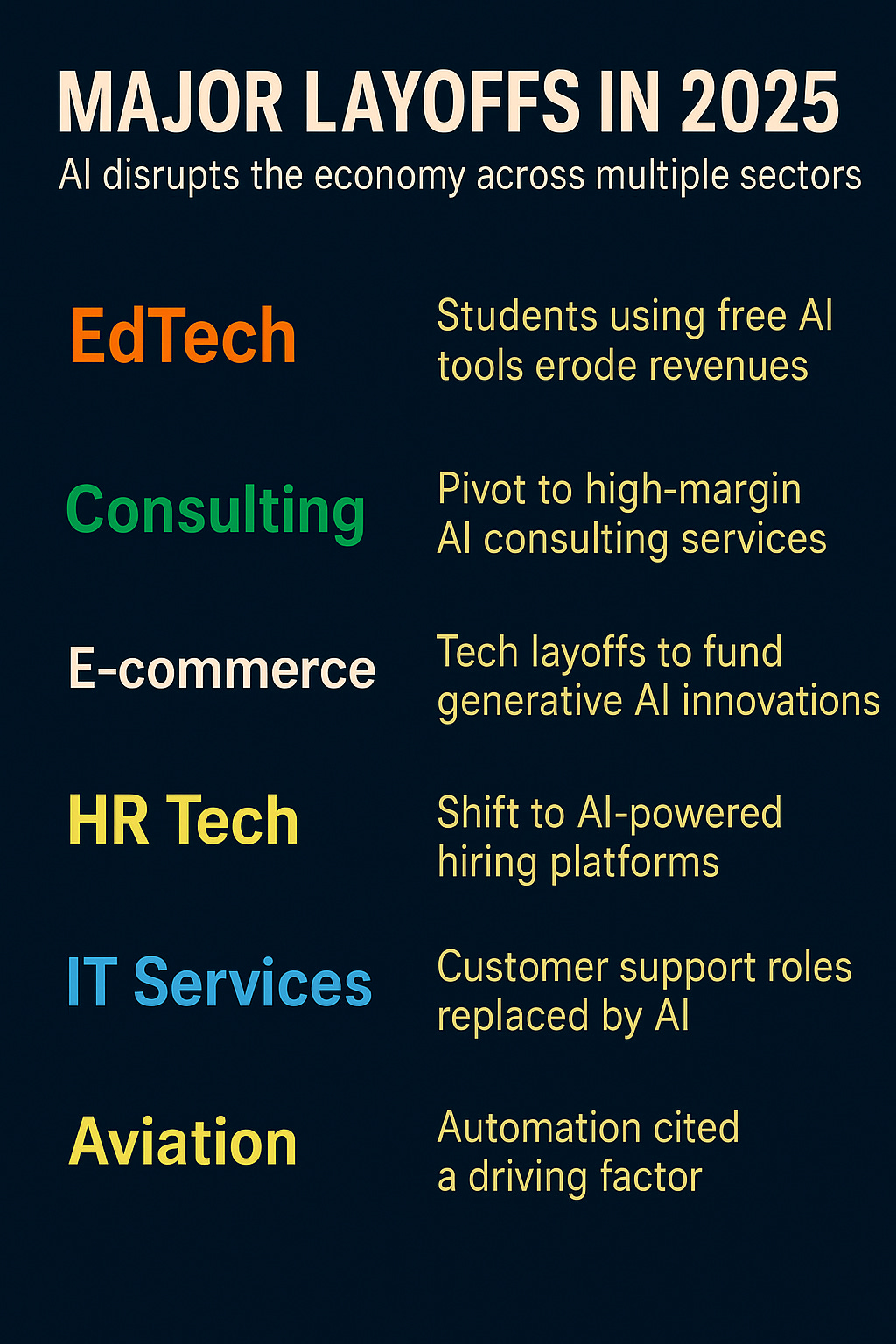The Geometry of Work Is Changing
Behind the AI Layoff Headlines
Today I pulled together several 2025 AI layoff headlines and ran them through a systems-foresight lens to find the patterns. Each layoff cycle funds more automation, compresses another layer of coordination, and speeds up the shift from human-managed hierarchies to AI-supported, small expert teams.
What looks like job loss is really the early phase of a structural reset, the point where the geometry of work starts to change.
Micromanagers, unfortunately, are not expected to survive the transition.
System Implications for the Future of Work
a. AI as Workforce Geometry Redefiner
Firms are moving from pyramids (manager-heavy) → cells (AI + small expert teams).
This is a network-to-system shift, where humans supervise or fine-tune AI systems rather than coordinate other humans. The organization itself becomes a learning system.
b. AI Capital Loops
Each layoff cycle reinvests savings into AI, accelerating a powerful feedback loop:
Fewer humans → faster AI rollout → more productivity → more layoffs.
This mirrors the early Industrial Revolution’s automation cycle, but now it operates at information-speed, compounding change with every model release, capital reallocation, and workflow redesign.
c. Emerging Divide
The workforce is dividing into two archetypes:
Orchestrators – Those who design, prompt, and integrate AI systems.
Operators – Those replaced or governed by them.
This is not mass unemployment, it’s structural compression within new geometries of work, flatter, faster, and increasingly algorithmic.
Eventually, most organizations won’t look like hierarchies at all, but networks of small expert teams, cells where humans and AI systems work side by side to keep the whole system adaptive.
Foresight Outlook: New Work Cells
Here are five examples that show what AI + small expert teams could look like by 2030, grounded in plausible trajectories from 2025.
Defence and Security — The Decision Cell
Operational planning centers will no longer run 200-person watch floors.
Instead, a Decision Cell of eight experts oversees fleets of autonomous systems and intelligence agents.
AI continuously fuses sensor data, flags anomalies, and runs simulations of potential moves.
Humans focus on intent alignment, deciding what outcomes matter, validating model assumptions, and authorizing action when human judgment is required.
It’s faster, more agile, and far more accountable than the old command stack.Health Systems — The Diagnostic Cell
A rural hospital operates with a Diagnostic Cell: three clinicians, one nurse, and a suite of medical-AI copilots.
The AI agents triage cases, summarize histories, and run differential diagnoses.
Clinicians interpret ambiguous results, contextualize social factors, and decide care plans.
Instead of more staff, hospitals scale reach and accuracy, each team can serve thousands through tele-linked AI support.Climate and Infrastructure — The Resilience Cell
A coastal city’s Resilience Cell combines two engineers, an economist, and an AI cluster modeling micro-weather and infrastructure strain.
The AI anticipates flooding, recalibrates energy distribution, and simulates cost trade-offs for adaptation projects.
Human experts negotiate with political and community stakeholders.
AI manages the data; humans manage the social system.Media and Education — The Knowledge Cell
In education, schools no longer have large administrative hierarchies.
A Knowledge Cell of teachers, learning designers, and generative tutors co-create adaptive curricula.
The AI agents personalize learning trajectories, while teachers focus on critical thinking, mentorship, and community learning.
Curricula update weekly, not annually, because the system itself learns from student feedback loops.Enterprise Operations — The Strategy Cell
At a multinational firm, the CFO’s office now functions as a Strategy Cell: four analysts, two AI orchestration engineers, and a governance lead.
AI handles forecasting, compliance, and risk monitoring across markets.
The human team conducts scenario analysis, sense-making, and strategic framing.
Every quarter, the cell convenes a network of other cells to align decisions, replacing traditional reporting with continuous coordination.
Trajectory
Across all sectors, the pattern is consistent:
Fewer people managing information.
More humans designing systems, shaping intent, and overseeing machine judgment.
Success doesn’t depend on how much data an organization has, it depends on how well its cells translate data into effective action.
My Field Notes
Across my defence, government, and AI industry ecosystems, what’s visible is fragmentation. Governments are building ethical frameworks while industry scales autonomous systems. Militaries are experimenting with AI at the edge but still constrained by legacy command structures. Policy circles talk about governance; developers talk about capability. The real story is the widening gap between how fast systems evolve and how slowly institutions adapt.
I’m in Seoul, South Korea today preparing for the AI Summit, tracking how agent systems, vertical AI, and inference architectures are converging into a new form of operational intelligence. My focus this week is understanding how these architectures learn through themselves, how sovereignty shows up in compute, data, and ontology, and how these shifts will reshape decision systems.
What Individuals Can Do Now
The automation wave can feel abstract until you realize it’s already shaping how you work, learn, and make choices today.
The most practical response isn’t to resist AI, it’s to build fluency, agency, and adaptability inside it.
Learn to Orchestrate, Not Just Operate.
Understand how AI systems make decisions, where they fail, and how to guide them. The future advantage lies in steering automation, not competing with it.
Protect Judgment.
As machines take over output, human value shifts to framing, ethics, and context. Practice slow thinking, pattern recognition, and synthesis the qualities that make decisions trustworthy.
Build a Personal Learning Loop.
Don’t wait for formal retraining. Use AI as a tutor and sparring partner. Experiment, test, and iterate your workflows continuously, adaptation is now a skill.
Connect Across Systems.
The next opportunities won’t sit inside silos. Build relationships across domains - tech, policy, design, operations to see where intelligence and insight intersect.
Anchor Identity Beyond a Job Title.
Roles will change faster than ever, but your ability to sense shifts, learn quickly, and stay useful won’t.
The goal isn’t to predict the next wave, it’s to stay mobile enough to adapt to it.



Continue to guide us I like adaption note on your write up